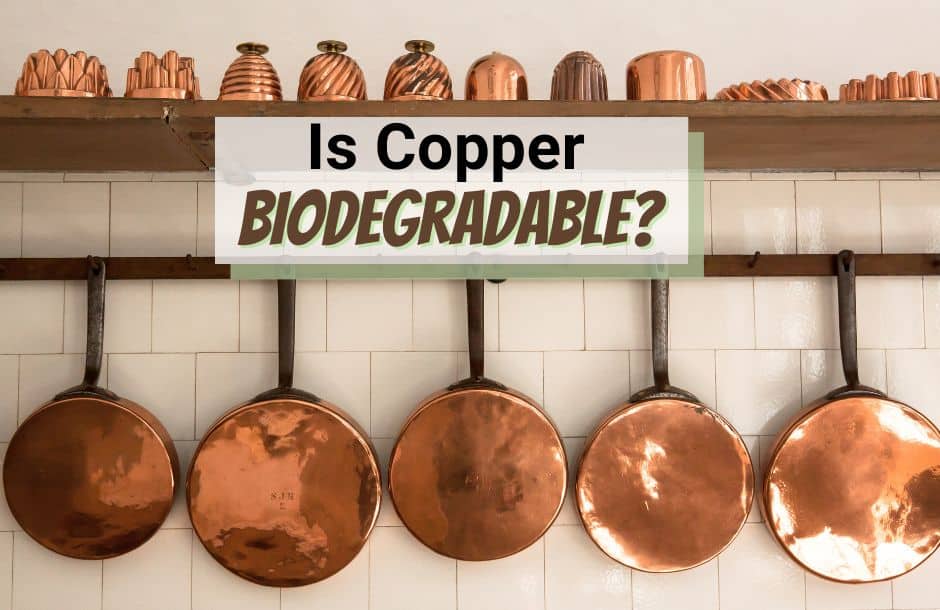Is copper biodegradable?
Copper is not biodegradable, meaning it cannot be broken down by living organisms. However, it is recyclable, so it can be reused indefinitely.
Introduction
Copper is a chemical element with the symbol Cu (from Latin: cuprum) and atomic number 29. It is a soft, malleable, and ductile metal with very high thermal and electrical conductivity. A freshly exposed surface of pure copper has a pinkish-orange color. Copper is used as a conductor of heat and electricity, as a building material, and as a constituent of various metal alloys, such as sterling silver used in jewelry, cupronickel used to make marine hardware and coins, and constantan used in strain gauges and thermocouples.
Copper is one of the few metals that occur in nature in directly usable metallic form (native metals) as opposed to needing extraction from an ore. This led to very early human use, from c. 8000 BC. Copper used in buildings, usually for roofing, oxidizes to form a green verdigris (or patina).
Copper is sometimes used in decorative art, both in its elemental metal form and in compounds as pigments. Copper compounds are used as bacteriostatic agents, fungicides, and wood preservatives.
What is copper?
Copper is a chemical element with the symbol Cu (from Latin: cuprum) and atomic number 29. It is a soft, malleable, and ductile metal with very high thermal and electrical conductivity. A freshly exposed surface of pure copper has a pinkish-orange color. Copper is used as a conductor of heat and electricity, as a building material, and as a constituent of various metal alloys, such as sterling silver used in jewelry, cupronickel used to make marine hardware and coins, and constantan used in strain gauges and thermocouples.
Copper is one of the few metals that occur in nature in directly usable metallic form (native metals) as opposed to needing extraction from an ore. This led to very early human use in several regions, from c. 8000 BC. Copper used in buildings, usually for roofing, oxidizes to form a green verdigris (or patina).
Copper is sometimes used in decorative art, both in its elemental metal form and in compounds as pigments. Copper compounds are used as bacteriostatic agents, fungicides, and wood preservatives.
What is biodegradation?
Biodegradation is the process where organic matter is broken down by microorganisms. This process is important in the environment because it helps to recycle nutrients and return them to the soil. Biodegradation can occur in different ways, depending on the type of material that is being broken down. For example, paper will decompose quickly in the presence of moisture and oxygen, while plastic will take much longer to degrade.
Different types of microorganisms can be involved in biodegradation, including bacteria, fungi, and worms. In general, these organisms will feed on the organic matter and break it down into simpler compounds. The process of biodegradation can be used to break down different types of waste, including food waste, paper, and even sewage.
Does copper biodegrade?
Copper is not biodegradable, meaning that it cannot be broken down by living organisms. However, it is recyclable, so it can be reused over and over again. While it doesn’t decompose, it can be corroded by water and air, so it will eventually break down into smaller pieces.
How long does it take for copper to biodegrade?
Copper is not biodegradable, meaning it cannot be broken down by bacteria or other living organisms. However, it is recyclable and can be reused indefinitely. When copper is exposed to the environment, it will slowly corrode and form a patina, or greenish-blue film, on its surface. This process is called oxidation and it protects the metal from further corrosion.
What are the benefits of copper biodegradation?
Copper is an essential trace element for many organisms, playing a role in a variety of biochemical processes. However, copper can also be toxic to cells at high concentrations. Therefore, organisms have evolved mechanisms to regulate copper levels and to degrade excess copper. Copper biodegradation is the process by which bacteria break down copper-containing compounds. This process can help to clean up contaminated environments and to prevent the buildup of toxic levels of copper in the body.
There are many benefits to copper biodegradation. First, it can help to clean up contaminated environments. Copper is often used in industry, and it can contaminate soil and water. Copper biodegradation can help to remove these contaminants from the environment. Second, copper biodegradation can prevent the buildup of toxic levels of copper in the body. When copper builds up to toxic levels, it can cause damage to cells and organs. Copper biodegradation can help to keep copper levels in the body at safe levels. Finally, copper biodegradation can be used to produce energy. Bacteria that can degrade copper can generate ATP, the energy molecule that cells use to power their activities.
Overall, copper biodegradation is a beneficial process that can help to clean up contaminated environments, to prevent the buildup of toxic levels of copper in the body, and to generate energy.
Are there any drawbacks to copper biodegradation?
Yes, there are some drawbacks to copper biodegradation. One is that it can release copper ions into the environment, which can be toxic to plants and animals. Another is that it can take a long time for the process to occur, and it may not be 100% effective. Finally, it requires a lot of energy and resources to break down the metal, so it may not be the most sustainable option.
Is copper eco-friendly?
Copper is a valuable resource that has been used by humans for centuries. It is a metal that is known for its electrical and thermal conductivity. Copper is also a component of coins, jewelry, and other decorative items.
Copper is a resource that is abundant in the Earth’s crust. It is also a resource that is recyclable. Recycling copper helps to reduce the amount of copper that is mined from the Earth. This is important because copper mining can have a negative impact on the environment.
Copper is a valuable resource, but it is also a resource that can be recycled. Recycling copper helps to reduce the amount of copper that is mined from the Earth. This is important because copper mining can have a negative impact on the environment.
Conclusion
There is no one-size-fits-all answer to the question of whether or not copper is biodegradable. The answer depends on the specific circumstances and environment in which the copper is present. In general, however, it is safe to say that copper is not particularly biodegradable. This is because copper is a very stable element that does not readily break down or react with other substances. While copper may eventually corrode or be broken down by natural processes over a very long period of time, it is not considered biodegradable in the traditional sense.

